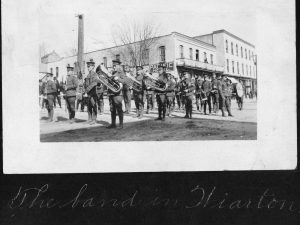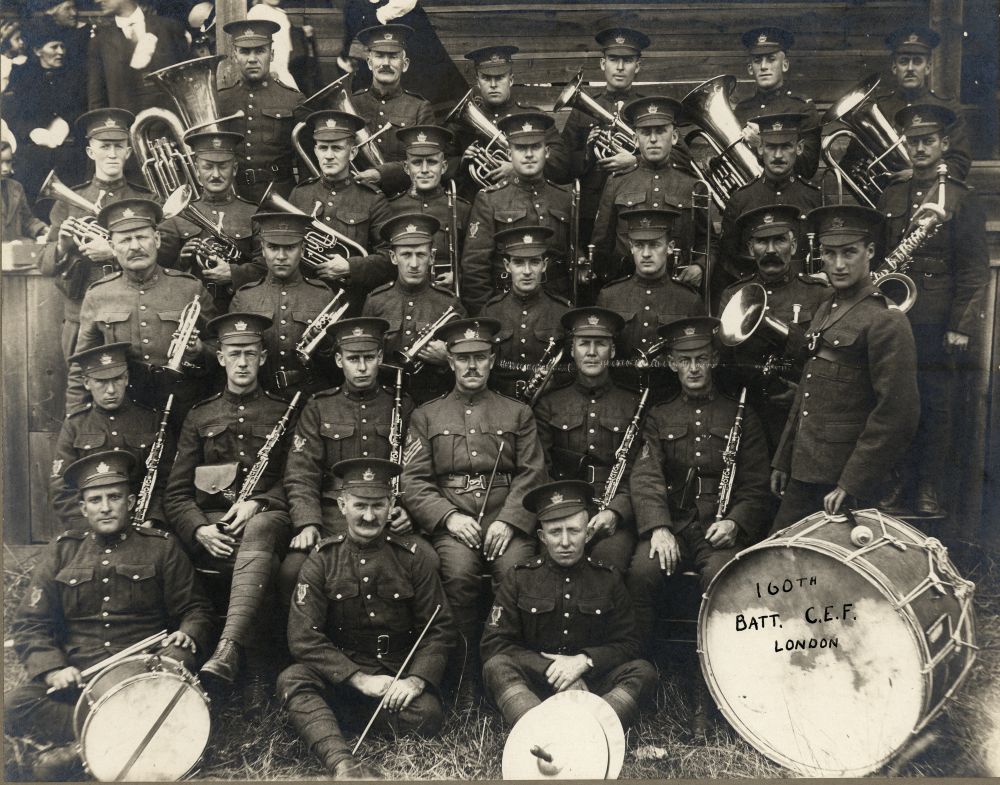First known as the “Chesley Mechanics’ Band” the Chesley Citizens’ Band was formed in 1887, under the leadership of John Krug. Attracting talented musicians with promises of employment at the Krug factory, the band became the main source of entertainment in the town. They played at weddings, funerals, holidays, the skating rink, and garden parties. News of their talent spread, and in June 1910 they were selected as the 32nd Regimental Band.
During the First World War, the Chesley Band’s military service continued. Although the Canadian Department of Militia and Defence did not fund regimental bands, many civilian bands – including Chesley’s – enlisted. On December 2, 1915, Lt. Col. Adam Weir, former commander of the 32nd Bruce Regiment, was instructed to form a Battalion made entirely of Bruce County citizens. Four companies were mobilized: A Company from Walkerton, Cargill, Paisley, Port Elgin and Southampton; B Company from Chesley, Tara, Hepworth and Teeswater; C Company from Wiarton, Lion’s Head, Tobermory, Cape Chin and the First Nations; and D Company from Kincardine, Lucknow, Ripley and Tiverton. Two soldiers were identified as making up the Transport Section of the 160th Battalion. Volunteering to the 160th Bruce Battalion in 1916 under their bandmaster, George Wright, the band was the central attraction on County recruitment tours. Newspapers, including the Canadian Echo, heralded their arrival with headlines proclaiming, “The 160th Regimental Band Coming Here” (February 16, 1916). By May, citizens had great hopes for their performance overseas: “Music has a wonderful charm and inspiring effect […] and the Bruce Band may yet cheer our boys in the field of battle” (May 3, 1916). The Bruce Battalion would be “the best equipped…morally…that ever crossed the sea” (March 8, 1916).
On October 18, 1916 the Battalion departed for England with the band under the baton of Sgt. William Jack. Once in England, they were stationed at the Bramshott Camp in Hampshire, and later in Surrey at Witley Camp. Here, they were once again the main entertainment, playing concerts and dances, in addition to regular drills. The band kept morale high, using music’s uplifting powers to inspire the troops.
The band remained in England until February 1918 when the battalion was split between various regiments and sent to France. During this time, the band played “Auld Lang Syne” as the soldiers boarded trains, and provided entertainment at the officers’ farewell dinner. As was recorded in the 160th Canadian Infantry Battalion War Diaries, “the band [was] a credit to the battalion.” By the end of February, the band, too, was divided and sent overseas.
After the war, the Chesley Band was revived. The Band participated in competitions such as the Waterloo Festival six times, and the CNE in 1937 and 1938. In 1959, reorganization of the band resulted in its financial accounts being incorporated with the recreation council of the Town of Chesley. In the 1950s, annual Band Tattoos and euchre dance nights were common. In later years, the Band also provided music at parades for Santa Claus, Remembrance Day, Churches, Fall Fairs and Ploughing Matches.The Chesley Band continued their legacy until 1999
Sources: Canadian Echo newspaper; “From Days of Yore: A Pictorial History of Chesley” (A995.070.001); Chesley Women’s Institute Tweedsmuir Community History Vol. 3; War Diaries – 160th Canadian Infantry Battalion (from Library and Archives Canada); Historical Notes (A2006.044.001)
For more photographs and information about the Bands of the 160th Battalion, visit Bruce County Museum’s Online Collections site: Bands, 160th Battalion, Bruce County Museum Online Collections.


